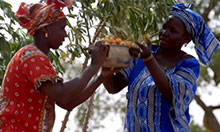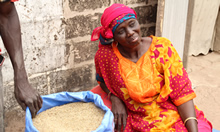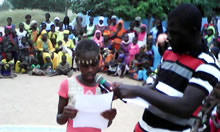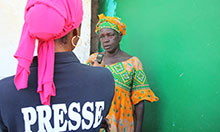Our Social and Behavior Change Communication Strategy
SPRING/Senegal works with partners to improve household nutrition by increasing awareness and demand for appropriate nutrition-related practices and services. Community radio programs, which have a wide audience in SPRING’s three intervention areas, are a key element of our social and behavior change communication (SBCC) strategy. We use radio, video, and community mobilization events to disseminate information on themes related to nutrition, nutrition-sensitive agriculture, hygiene, and gender.
Key Themes of SPRING’s Radio Programming
Starting in 2016, SPRING partnered with six local radio stations to produce and air 60-second spots on high-impact nutrition and hygiene practices. The radio stations—Niombato FM, Ndef Leng FM, Kaffrine FM, RIP FM, Alfayda FM, and Koungheul FM—broadcast from Nioro, Foundiougne, Koungheul, Kaffrine, Fatick, and Kaolack, with a reach that covers SPRING’s entire intervention area.
- Vegetable gardening to improve nutrition and income in the household, especially promoting the orange-fleshed sweet potato
- Critical moments for handwashing and household hygiene
- Men’s role in reducing women’s workload in the household
- Exclusive breastfeeding and introduction of nutritious complementary foods after six months
- Raising poultry as a source of household protein and income.
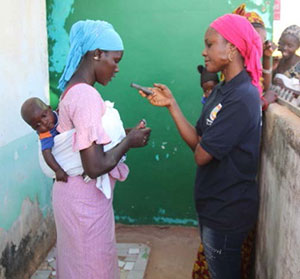
A Match Made in Media: Complementary Community Video Programs
In addition to radio spots, produced with technical support from SPRING staff, the stations aired interactive radio programs. Using a talk show format, they promoted nutrition-related messages through live interviews with influential community members, health workers, and representatives from agricultural partner networks. Each month’s theme complemented the community videos that SPRING partners disseminated that month during women’s group meetings, community meetings, and household visits.
Building the Capacity of our Radio Partners
From November 2016 to July 2017, SPRING and our partner radio stations broadcast—
- 14,280 radio spots featuring nutrition messages
- 30 interactive radio programs.
SPRING trained radio partners on nutrition-sensitive and nutrition-specific messages and worked with them to develop engaging radio content for these topics. We organized exchange visits between radio stations to encourage the sharing of experiences and successes between partners. We also established a monitoring system that enabled stations to track, evaluate, and capitalize on their monthly broadcast schedules.
Radio station managers reported that working with SPRING increased their audience, drew interest from other implementation partners and non-profit organizations, and helped position themselves as key players in promoting good nutrition practices. Furthermore, their audiences found the nutrition-related broadcasts so engaging that the stations broadcast the programs and spots more often than the contract required (at no cost to SPRING).
Recommendation: Conduct regular and participatory monitoring of the radio broadcasts to maintain the dissemination schedule and high-quality broadcasts.
SPRING formed listening groups, selected from partner community organizations and networks, to listen to radio spots and programs and take notes on the timing, topics, presenter’s skill and approach, and sound quality. Using these records, we followed up monthly with the stations, providing tailored recommendations to improve programming impact. This prompt and recurrent feedback cycle strengthened the collaboration between SPRING and the radio stations and fostered a joint commitment toward sharing these critical messages to benefit the population.
Maximizing the Reach of Nutrition-Related Messages
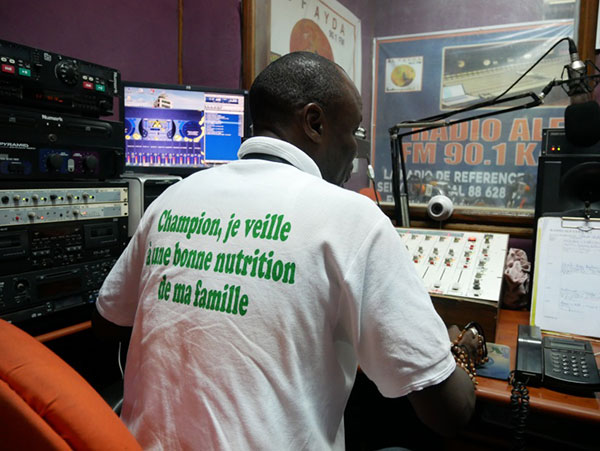
Because radio is the primary source of information in our intervention area, SPRING worked with radio partners to disseminate nutrition-related messages as often and as efficiently as possible. We selected radio partners based on geographic coverage, popularity with the target audience, and availability of technical and human resources to support our programs. To maximize saturation, we broadcast radio spots seven days per week, up to 10 times per day, and we aired the longer radio programs twice a week. To reach our audience, it was vital that we select popular time slots to broadcast the nutrition-related messaging. Most listeners tune in at 8 a.m. or at 8 p.m.; they are less likely to listen to the radio during the middle of the day. When radio stations were unable to follow the dissemination plan because of power outages or major ceremonies, they broadcast the episodes in the next available timeslot.
To grab the audience’s attention, we developed interactive radio programs that featured local actors speaking the local language (Wolof). Radio staff also visited SPRING’s community video dissemination events and recorded participants’ reaction to our videos, which were then broadcast during subsequent radio programs. The themes of the radio programs and community videos were also linked to our social mobilization campaigns that showed target behaviors. For example, we aired radio spots and programs on handwashing and disseminated our community video on hygiene to coincide with Global Handwashing Day, where our community mobilization events included tippy-tap construction demonstrations.
Outside groups disseminated our messages even farther than the primary radio listeners. SPRING’s listening groups, which were only responsible for monitoring and recording, voluntarily played the radio programming at neighborhood council and village meetings. Community health workers and women’s groups also took the initiative to share the messages during their meetings. These additional dissemination opportunities reinforced the desired knowledge and behaviors relating to nutrition, hygiene and sanitation, gender, and agriculture.
Recommendation: Produce radio commercials in multiple local languages, not just the most frequently spoken language.
SPRING initially produced some radio commercials in French, but switching to Wolof increased the audience’s understanding. Producing radio programming in additional local languages would expand the nutrition-related message’s reach even more.
Impact of Radio on Nutrition-Related Knowledge and Practices
Figure 1: Percentage of respondents who recalled radio messages by theme
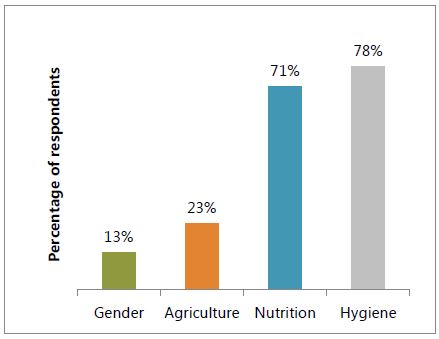
In July 2017, SPRING interviewed 95 randomly sampled men and women between 18 and 65 years old, all of whom lived in villages reached by our radio partners (65 women and 30 men). From SPRING’s radio programs, radio listeners reported learning about hygiene, the benefits of exclusive breastfeeding, the importance of complementary foods for children ages 6 to 24 months, and the link between gender and nutrition. Of the interviewees, 78 percent could state the critical moments for handwashing, the benefits of a tippy tap handwashing device, and the importance of keeping the bathroom clean.
One father felt that since encouraging his family members to practice handwashing more regularly, everyone’s health had improved and they were making fewer trips to the clinic:
I am purchasing fewer prescriptions, and this is clear from my daily savings!
Of the respondents, 71 percent reported learning the benefits of exclusive breastfeeding from the radio programs. A mother from Koungheul department said—
My five-year old girl repeats this spot to me, ‘ayo nene’ (“all day long”), and that’s what attracted my attention to this message. Now, I understand that everything a child needs in their first six months is contained in breastmilk and that exclusive breastfeeding protects against diseases.
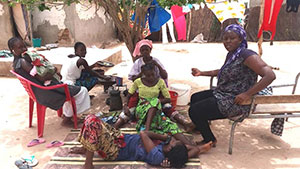
Of the listeners, 13 percent recalled messages about gender and the equitable division of household tasks between husband and wife. One woman reported—
My husband watches the kids when I am busy with other chores. Better, he helps me even when he knows everyone in the village is aware. Before, he would help out with my most demanding tasks, but his support was reinforced by the radio spot ... And I keep saying, it’s not because he feared me that he helped me.
Some radio listeners encouraged fellow community members to adopt good nutrition-related practices in addition to applying what they learned to their own household. With encouragement from the chief of his village, one Qur’anic teacher in Kaffrine organized a social mobilization event promoting hygiene, nutrition, and gender, based on the radio spots he heard.
Recommendation
Respondents were least likely to recall messages relating to gender equity—it is possible that this topic is less familiar to the audience than handwashing or exclusive breastfeeding. It would be beneficial to put greater emphasis on gender-related messages, with detailed examples of how men can help women reduce their workload in the household.
Conclusion
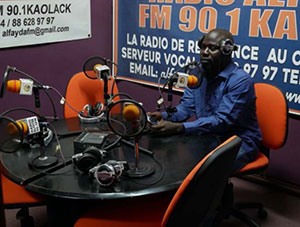
SPRING/Senegal’s partnership approach simultaneously builds the capacity of the existing organizations and broadens our reach in changing nutrition-related behaviors across all our intervention areas. By working with radio stations, we could increase our audience at a low cost and assist local radio stations to develop new skills in communication and monitoring and evaluation. Additionally, our partners produced radio spots and programs that reinforced our SBCC work in community video and community mobilization events, saturating the intervention areas with target messages. Through these methods, SPRING aims to achieve lasting results in nutrition-related behavior change.
